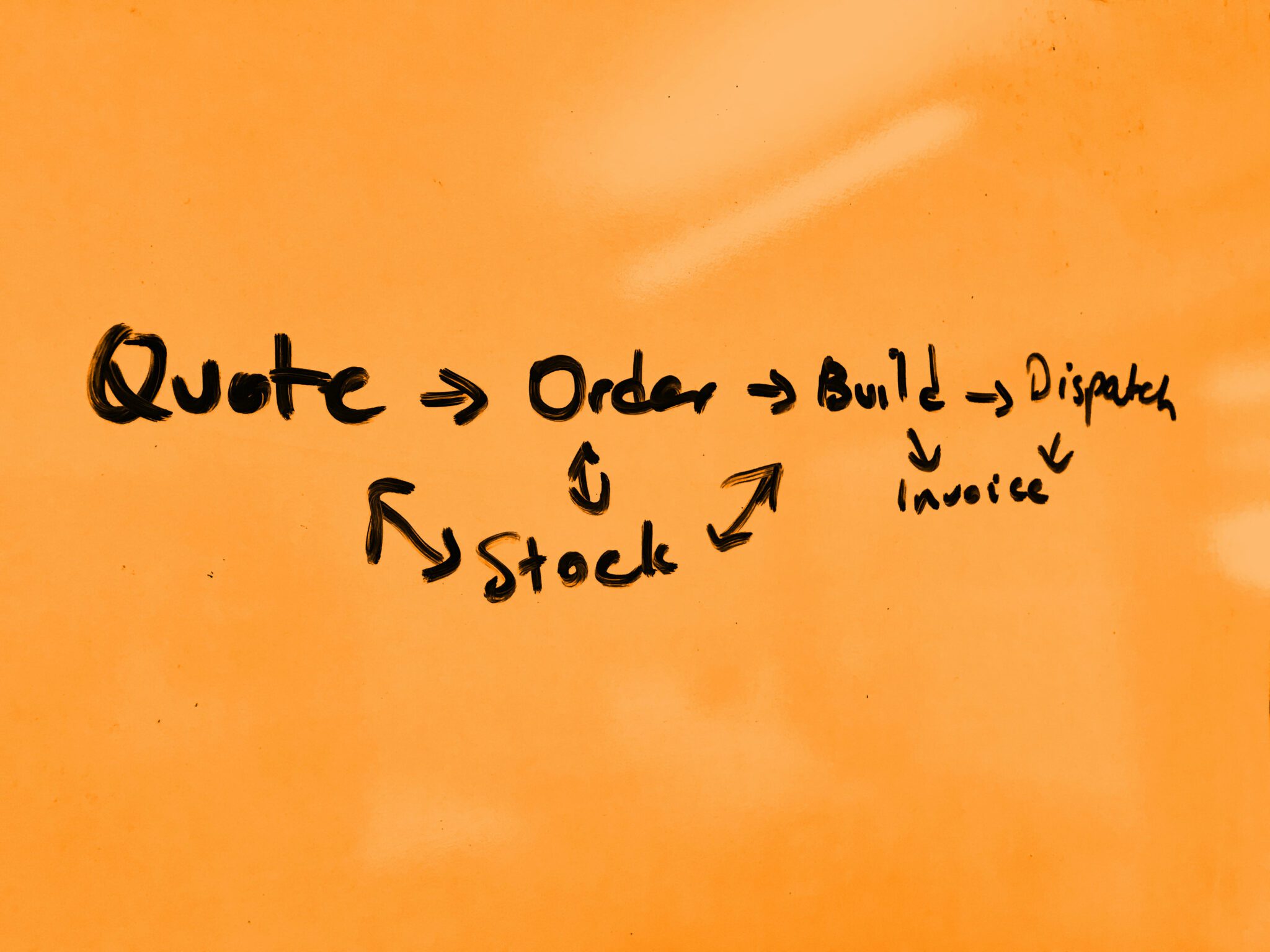For most manufacturing businesses, mastering Material Requirements Planning (MRP) is crucial for success. But what exactly is MRP, and how does it function within your operations? In this guide, we’ll break down the essentials of MRP, explaining how it works, why it’s important, and how it can streamline your manufacturing process, improve efficiency, and drive growth.
What is MRP?
MRP stands for Material Requirements Planning. It was the first computerised procedure for supply planning, and as you can learn within this article on the history of MRP, it was first implemented in the 1970s.
With the right MRP system in place, manufacturers are able to streamline their planning, production and inventory control. Without something to help them with their inventory management processes, they can run out of the manufacturing items they need and find themselves in a position where they are unable to fulfil their customer orders. With MRP in place, however, they will be in a better position to plan their operations and have the tools needed to control and organise the logistics of their inventory.
Ultimately, an MRP software is essential to the effectiveness and efficiency of any manufacturing operation. It can make all stages of the production process run more smoothly, especially during the later stages where there can sometimes be a risk of inventory shortages. The manufacturer will then be happy when their manufacturing operation is able to run to schedule and the client will be happy when they receive their order by the agreed deadline.

How Does an MRP System Work?
MRP software uses information from the bill of materials (BOM), master production schedule, and inventory data, and uses these to calculate the required materials for any given project.
The MRP system can allow users to allocate or reserve the stock needed from the manufacturers’ inventory and raise purchase orders for any extra materials that are required.
See how Flowlens helps streamline SME equipment, device and machinery manufacturing.
The Benefits Of MRP Systems
With an MRP system in place, you can simplify the processes that are needed in your materials requirement planning. While some manufacturers will organise their MRP with spreadsheets or even just in their heads, you will find it easier to use the software that will save time and eliminate the possibility of human error. There are many benefits to using an MRP system. These include:
- Excellent customer service: When you utilise an MRP software within your business, you can deliver your project on time to the customer.
- Avoid material shortages: Shortages can lead to delays in work and unhappy customers, but with MRP, you need never run out of materials again.
- Improved production scheduling: With MRP, production managers will know when production operations need to be carried out.
- Manage cash: MRP can help you limit the amount of cash you have tied up in stock on hand, whilst ensuring on-time delivery to customers improves the invoice to cash cycle – ie. get paid faster!
Risks and Rewards
For small manufacturers, the benefits of new software such as MRP systems have to be considered carefully. There are risks to be aware of and rewards to reap from more efficient ways of working.
Happy customers are profitable customers. They buy more, and refer more. But poor systems and processes, or even a bad implementation of a good piece of software can get in the way of delighting customers.
What are some of the main benefits of adopting cloud manufacturing tools for your equipment manufacturing business?
Forecasting material demand and avoiding shortages
The worst outcome is a disappointed customer, and disappointment usually comes because manufacturers miss promised delivery dates, or items are not built to the specification originally agreed with your sales person.
Delays typically occur because vital components are not available at the right stage of the production process. Long lead time items hidden in the bill of materials can play havoc with delivery dates, never mind the cash tied up for longer than needed in work in progress.
Cash is king for all companies, but the pain is felt most by smaller manufacturers. The benefit MRP systems bring is the data from your order book and bill of materials that highlights stock/inventory requirements. In particular these show the components that need to be ordered or made in order to ensure deadlines are met.

“Being able to go through the sales order itself on Flowlens and generate a project from this sales order, is amazing. It gives us the ability to see what’s available in stock, what needs to be made, and if there are any special requirements for the project we are dealing with. So being able to, plan our projects, plan our production route, our production requirements, it just enabled us to do things better. It’s like having extra links of communication that we’ve missed before.”
Ahmed Alainiah – Technical Operations Manager – Talbott’s Biomass Energy Systems.
Build It Right First Time
There is nothing worse than delivering on-time, but then discovering there has been something missed in the spec, usually something that was written down or shared verbally. This is particularly important for companies who build or engineer to order.Manual systems and processes are often ‘fuzzy’ and cause errors and communication problems.
Manufacturing resource planning software, linked to sales quotation and order processing functions can help ensure that the requirements offered to and agreed by the customer, and the requirements that make it into production. Manufacturing tools generate the actual bill of materials for a customer order based on the products and options chosen. These requirements feed directly into material requirements planning and production tracking.
This means you benefit from clear material requirements, your customers benefit by getting the product they ordered!
Order Components and Materials Efficiently and Just In Time
Many equipment manufacturers struggle to cross reference current stock levels with new demand, as well as lead times for items. This leads to:
- excessive stock holding of slow-moving items, tying up cash and often resulting in write-offs
- Piecemeal ordering of items on a per-job basis, resulting in wasted time or overpaying for items that could enjoy bulk discounts
- Paying for expensive components before they are needed, tying up cash unnecessarily
Lean manufacturing software can address these problems and your bottom line feels the benefit. MRP Software for small manufacturing businesses includes Purchase Order functionality built-in. It can reduce these problems by giving you a clear picture of your current demand versus available stock, what’s on order and overall demand across all jobs, and indicate lead times for items that can be purchased just in time.
A further benefit you’ll find in some small manufacturing MRP systems are Purchase Order Spend Approval workflows. This enables owners and managers to control the issue of purchase orders to suppliers by person and or limit purchasing by monetary value.
Bill of Materials Management
Many small manufacturers struggle to keep on top of the latest and most accurate versions of their product and sub-assembly bills of materials. In many cases this information isn’t stored, but remains in someone’s head. This is a huge risk, if that knowledge leaves the business, even for a week’s holiday!
MRP systems can benefit small machinery and equipment manufacturers by capturing and maintaining up to date bills of materials for finished goods and sub-assemblies. With version control and historical information you have a record of changes and customer order patterns too.
For example if you need to find orders for a certain version of a product and refer to the bill of materials active at that time, how easy would it be with your spreadsheet based systems?
Benefits of MRP software for small businesses also include traceability of serialised parts and finished products, another task usually handled on spreadsheets. When something goes wrong, you’ve got the information at your fingertips, rather than hours or days trawling through paper and spreadsheets.
How often have you had to trace back through emails and spreadsheets to find the serial number of a faulty component? The process of adopting MRP software usually provides the added benefit of structuring your parts, BOMs (bill of materials) and product serial number data to create a clear and consistent method that the business can follow.
Accurate Material and Job Costs & Profitability
Modern MRP systems will track the materials and labour used on each manufacturing job, enabling tracking of how much individual jobs are contributing to the bottom line.
By enabling real-time allocation and stock adjustments, it becomes easier to track actual material usage, rather than relying on after-the-fact manual stock reconciliations.
Parts and Supplier Management
Keeping on top of parts data is a time consuming job for most equipment / machinery / plant manufacturing businesses. Parts lists are usually spreadsheet based and require a lot of maintenance to avoid the kind of errors and discrepancies that eventually lead to shortages in production.
On top of this, there is very little time left to review and challenge supplier performance. Information about supplier delivery performance as well as price competitiveness is not readily available when manual systems are in play.
Small manufacturing companies benefit from joined up stock management, MRP / requirements planning and purchase order processing which provides supplier performance information, on-time (or not) delivery data, returns etc at the touch of a button. Furthermore, supplier price fluctuations can be hard to track over time, but these variations can also be easily spotted when data is captured in a structured and easy to interrogate way.
Trust Your Financial Data
With sales pipeline, orderbook, purchase ledger and work in progress data often spread over various independent systems or spreadsheets, small manufacturing businesses can struggle to get real-time and reliable information. This leads to cashflow constraints, either because orders are delayed, or cash is committed to inventory for longer than needed.
Modern MRP forms part of integrated suites of tools designed to benefiting owners, managers and team with one centralised business management system. Current order book, future pipeline, purchase orders and work in progress can be monitored live in one place, enabling better budgeting, smarter decisions and less stress.
Release time for more valuable work
MRP Softwares provide other less tangible benefits that usually make the difference to business sustainability and growth in the longer term.
Whether it is company directors who still spend hours in manual spreadsheets for operational or reporting reasons, or team members who spend hours every day chasing purchase orders, an MRP software saves time across a small manufacturing business.
Not only does this release time for more valuable tasks, its reduces dependence on manual admin resource allowing the business to become more sustainable.
“So it was really important that we had a system that wasn’t just a standard CRM system that managed communications with the customer, but allowed us to be able to manage our stock levels and coordinating as well to make sure we had the right stock at the right time. So we were able to manage the business more effectively.”
David Lincoln-Lewis – Commercial Director Industrial Switchgear

Quality Management
Many equipment and device manufacturing companies run standalone Quality Management Systems in order to evidence their compliance with standards such as ISO9001. A well implemented integrated cloud manufacturing CRM and MRP system can provide the basis for real-time quality management.
Key to any QMS is demonstrating clarity and consistency of the business process followed, with key data captured at relevant stages, and exceptions or problems captured and handled. This enables an culture of continuous improvement that only leads to better ways of working and adding value to the customer.
However most companies still scramble to manually provide evidence of quality management prior to an auditor visit, something that consumes hours or days effort for no return.
By embedding your Quality Management System within your MRP system you can provide evidence in real-time and know that your team are following a well defined process.

“We have been using templates within Flowlens, under the forms area. and created workflow forms. Corrective action being a really good one. So a supplier, when we need to issue a corrective action on them, we just generate the form against the supplier, automatically track it through Flowlens.”
Ray Dodd – General Manager – On Systems
Teamwork Benefits of MRP Systems
Small Businesses who invest in MRP systems typically benefit from higher morale and job satisfaction. Employees are able to spend more time on valuable activities instead of boring, repetitive and frustrating administration.
Successfully deployed MRP software, often linked to sales and accounting systems, makes it easier for people to do a good job.
Even when things go wrong, the systems and processes that MRP software instils can help the team identify and address problems faster.
And a happier team, means happier customers.
How Do I Choose the Right MRP System for my Business?
Download our free guide: How to choose software for your business.
With Industry 4.0 technologies going mainstream, you might feel overwhelmed by the options available. Rest assured, affordable, modular software is available to small manufacturing businesses looking to overhaul their processes, reduce costs and minimise risks.
Cloud manufacturing and MRP systems are an excellent solution for decreasing confusion and manual effort at your firm, while enhancing customer satisfaction.
But how can you decide on the most suitable software for your business?
We’re no longer in the era of ‘one-size-fits-all’ platforms
Different firms have different business processes. This means they need the most appropriate types of software for their needs. A standardised platform that requires major customisation and significant reorganisation in order to lock its complete functionality is simply no longer good enough.
The range of types of manufacturing company out there – with their varying processes and demands – further complicates the task of coming up with the right software to cater to these needs.
At a high level, a cloud manufacturing systems should:
- Provide information about current orders
- Enable the planning and execution of manufacturing tasks
- Allow the tracking of time, materials and activities for each order
- Forecast material needs and issue purchase orders
- Schedule production
- Monitor wastage and problems in relation to delays and defects
- Connect to other business processes like sales, stock and finance
- Provide all-round visibility of your firm’s manufacturing operations
Choosing a software grants you further advantages such as ease of access, an intuitive interface, and integration with other platforms like finance or CRM. Flowlens software, for instance, combines CRM and manufacturing platforms within one solution.
Pick the MRP System that caters to your firm’s manufacturing style
Various forms of manufacturing software exist to suit different styles. Lower-volume manufacturing businesses naturally differ from high-volume businesses in their requirements. There are also differences between the requirements of equipment manufacturers (OEMs) and component manufacturers, unless the former produces everything in-house.
The Flowlens cloud MRP software is geared towards the needs of small and medium-sized equipment and device manufacturers and dealers. This focus enables us to provide the most capable and relevant possible product for these businesses, as well as effective, tailored onboarding and training services.
While there is other softwares on the market that is said to support multiple manufacturing modes, you will often discover that even these platforms originate from one specific process.
Determine the most suitable product for your business
To begin to narrow down your options for cloud manufacturing software, ask yourself what form your business processes take. Alternatively, think of it in terms of what your firm’s value chain is. Identify the steps that occur in your business that allow you to generate value for your customers.
Mapping out these steps using a whiteboard or flowcharting tool will make it easier for you to distinguish between suitable and not-so-suitable software-based systems. If you’d like some help mapping your processes, we offer this as a service – get in touch to learn more.
Download our free eBook today that will help you to select the right software for your organisation. You can also review our customer case studies, request a demo or begin a no-obligation free trial of the Flowlens software to discover what a transformative effect it could have on your business.

Conclusion: Small Manufacturers Reap Many Benefits of MRP Systems
In summary, if you are ready to put old and disjointed ways of working to one side, MRP systems have many benefits, transforming small manufacturer’s processes and improving communication. This reduces strain on the owners and team, reduces errors and gives better outcomes for customers.
Watch a demo to see how Flowlens can help you save time, improve profit and customer satisfaction.





